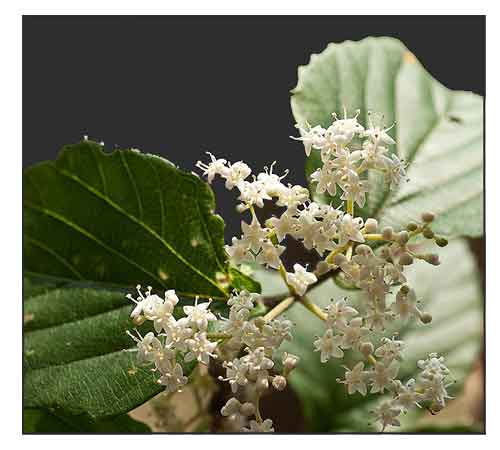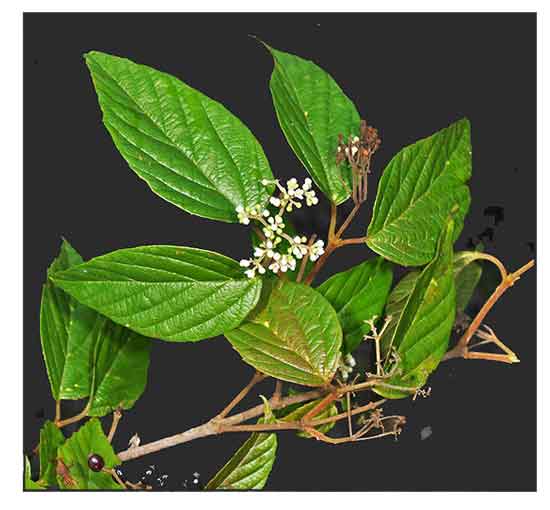 Gen info Gen info
- Viburnum is a large group of more than 150 species and numerous cultivars, which include deciduous and evergreen shrubs and small trees,
- Previously belonging to the family Caprifoliaceae, it has been recently moved to the family Adoxaceae. - Genus name derives from the Latin name of a species plant. The species epithet derives from Luzon, the largest of the Philippine islands.
Botany
Viburnum luzonicum is a large deciduous shrub or small tree, with a dense mounded habit, growing 3 m tall, feet tall, occasionally reaching 5 m. Bark is light brown. Branchlets are yellow-brown to dark-purplish brown, stellate-pubescent, with dispersed, small, rounded lenticels. Leaves are opposite, stellate pubescent; leaf blade yellowish-green when young, elliptic-ovate to ovate-lanceolate, sometimes subrhombic, 4-9 x 2-5 cm, papery to thickly papery, abaxially sparsely stellate-pubescent or forklike pubescent, adaxially with transparent glandular dots and forklike pubescent on midvein, midvein raised abaxially, lateral veins 5-9-jugaate, pinnate, straight or slightly arched, rarely branched, ending in teeth conspicuously raised abaxially, impressed adaxially. Flowers are white, small, occurring in compound umbel-like cymes, with a drab, slightly unpleasant fragrance. Flowers are followed by fruits. Fruits are ovoid, 5-6 mm, base rounded, apex rounded, glabrous. Fruit a 1-seeded drupe with a ± compressed pyrene, red, purplish, black, or rarely yellow when mature. (1) (2)
Distribution
- Native to the Philippines.
- Also native to China, Maluku, Taiwan, Vietnam.
- Seen in open forests and roadsides.
 Constituents Constituents
- Study of methanol extract of dried leaves isolated four new iridoid aldehydes bearing (E)- or (Z)-p-coumaroyl group, luzonial A (1), luzonial B (2), luzonidial A (3), and luzonidial B (4). (see study below) (3)
- Study of dried leaves yielded four new iridoids glucosides (1-4) and seven new iridoid aglycons (5-11) bearing (E)- or (Z)-p-coumaroyl groups were isolated from a methanol extract of the dried leaves of Viburnum luzonicum collected in Kaoshiung, Taiwan. The structures of the new compounds, named luzonoside A (1), luzonoside B (2), luzonoside C (3), luzonoside D (4), luzonoid A (5), luzonoid B (6), luzonoid C (7), luzonoid D (8), luzonoid E (9), luzonoid F (10), and luzonoid G (11), were elucidated by analysis of spectroscopic data and comparison with values for previously known analogues.
(see study below) (5)
- Study of stems isolated two new phenolic allopyranosides, viburluzosides A and B (1,2) along with 8 known phenolic glycosides (3-10). (see study below) (8)
- HPLC study of leaves yielded three new phenolic compounds, viburosides A-C (1-3), along with seven known analogues (4-10). (see study below) (9)
Properties
- Studies have suggested cytotoxicity, anticancer, alpha-amylase, alpha-glucosidase, aldose reductose inhibitory properties.
Parts used
Leaves, fruits.
 Uses Uses
Edibility
- No studies found on the edibility of Viburnum luzonicum berries. While some species are edible (V. lentago) are edible, eaten raw or made into jam, some are mildly toxic and can cause vomiting when eaten in quantity. (Among the reported edible Viburnum berries are Viburnum alnifolium, V. cassinoides, V. edule, V. lantan, V. lentago, V. nudum, V. opulus, C, prunifolium, V. rufidulum, C. setigerum, and V. trilobum.) (6)
Folkloric
- No reported folkloric medicinal use in the Philippines. .
Others
- Agroforestry: Used as shrub borders, screens, foundations or hedges and open woodland gardens.
- Pigment: Fruit yields a red pigment. (see study below) (4)
Studies
• Cytotoxic Iridoid Aldehydes: Study isolated four new iridoid aldehydes from dried leaves of V. luzonicum collected from Kaoshiung, Taiwan. Compounds 1-3 exhibited moderate inhibitory activity against HeLa S3 cancer cells. (see constituents above) (3)
• Red Pigment / Color Stability / Fruits: Study evaluated the stability of red pigment in fruits of V. cumulonimbi and factors influencing color stability. In vitro study showed the pigment was stable below 60°C and at pH <4 but sensitive to high temperature, strong light, and oxidation-reduction media. Some minerals can alter color, cause precipitation, and decrease stability, while some showed a certain color maintenance and increase color stability. Vitamin C enhanced degradation and decoloration of the red pigment, which showed a significantly negative relationship between coloration and vitamin C concentration. (4)
• Iridoid Glucosides / Anticancer / Leaves: Study of dried leaves yielded four new iridoids glucosides (1-4) and seven new iridoid aglycone (5-11) bearing (E)- or (Z)-p-coumaroyl groups. The structures of the new compounds, named luzonoside A (1), luzonoside B (2), luzonoside C (3), luzonoside D (4), luzonoid A (5), luzonoid B (6), luzonoid C (7), luzonoid D (8), luzonoid E (9), luzonoid F (10), and luzonoid G (11), were elucidated by analysis of spectroscopic data and comparison with values for previously known analogues. Among the iridoids isolated in the present study, glucosides 1 and 2, and their aglycone 5-9, exhibited moderate inhibitory activity against HeLa S3 cancer cells, whereas 3 and 4 showed no cytotoxicity even at 100 µM. (5)
• Alpha-Glucosidase and Aldose Reductase Inhibition/ Stems: Study of stems isolated two new phenolic allopyranosides, viburluzosides A and B (1,2) along with 8 known phenolic glycosides (3-10). Compounds 1-4 and 6-9 exhibited α-glucosidase inhibitory activities with IC50s of 5.35-21.34 µM and AR inhibitory activities with IC50s 6.21-40.06 µM. (8)
• Alpha-Amylase and Alpha-Glucoside Inhibitory Activities / Leaves: HPLC study of leaves yielded three new phenolic compounds, viburosides A-C (1-3), along with seven known analogues (4-10). In vitro enzyme assays showed compound 1-8 possess potent α-amylase and α-glucosidase inhibitory activities. (9) Study yielded five undescribed phenolic glycosides, viburozosides A-E (1-5). Compound 1 showed significant competitive inhibition against α-amylase (IC50 of 17.5 µM) and α-glucosidase (IC50 13.6 µM). (10)
Availability
Wild-crafted. |

![]()






